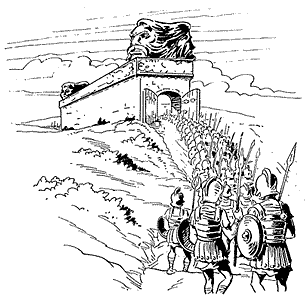Calendar, Januarius
(a Roman month in retrospection)
Januarius, a Month that Looks Forward to the Future and Backward to the Past?
The calendar used in western cultures and throughout the rest of the world; if not as the major calendar, then in parallel as a commercial calendar with the cultural calendars of some countries, is based almost completely on the Roman calendar system which we inherited from Julius Caesar and previous Roman calendars. The New-Style (a.k.a. Gregorian and Western) Calendar is the accumulation of a series of complicated systems that evolved over the centuries. The Ancient (or first-known) Roman calendar, traditionally attributed to Romulus, the legendary founder of Rome, contained ten months which were arranged as follows:
- Martius , March (31 days)
- Aprilis , April (29 days)
- Maius , May (31 days)
- Iunius ( Junius ), June (29 days)
- Quintilis , Fifth month (31 days)
- Sextilis , Sixth month (29 days)
- Septembris , Seventh month (29 days)
- Octobris , Eighth month (31 days)
- Novembris , Ninth month (29 days)
- Decembris , Tenth month (29 days)
- There was a total of 298 calendar days for the Roman years.
- Additional days and months were arbitrarily added by government officials through their priests to fill out the 365 days to complete the year.
- As the first month in the Gregorian, or New Style calendar, January consists of 31 days.
- The name (Ianuarius in Latin) is derived from the two-faced Roman god Janus.
- Some scholars believe that the derivation of the name Janus is from the Latin ianua, which means “door”; while others have explained the name to be the masculine form of Diana, which would be Dianus or Ianus (Janus).
- In Juno’s temples, the goddess was personified at her Gate (Janua Coeli, “Gate of Heaven”) with two faces looking in both directions—the outward passage of the Gate at birth and the reverse passage at death.
- At her festival in early January, she was addressed as Antevorta and Postvorta, the goddess who looks forward and backward, because January was the “gate” of the year, when the god of the Aeon died and was reborn from Mother Time.
- As the Roman religion became more patriarchal, Juno’s gate-keeping public image became an androgynous Janua-Janus, later it was wholly masculinized as the two faced god Janus to whom all gateways were sacred.
- Janus was an ancient Italic sun and supreme deity and he was responsible for opening and closing the gates of heaven every morning and evening.
- His name is the source of our English word “janitor” (originally, “door keeper” or “gate keeper”).
- As the god of spatial beginnings, he was the “protector” of gates and doorways; as the god of temporal beginnings, he took care of the first hour of each day.
- At one time, his name was mentioned first in prayers, even before Jupiter, and at the beginning of important undertakings.
- A theory about why his name came first is based on the idea that his intervention as the “janitor” of all avenues would speed prayers directly to the immortals.
- As the deity of all beginnings, Janus also had the title Consivius or “sower”, because of his role as the creator of agriculture.
- A local cult worshipped Janus on the Janiculan hill (interpreted as “door hill” or “city of Janus”) west of Rome on the bank of the Tiber River.
- There is one reference which states that his cult existed all the way back to Romulus and even during the period before the actual founding of Rome in 753 B.C.
- When it was discovered that the name Janus has the same Latin root as that of Diana, the moon goddess, the Romans even thought of him as a moon deity.
- On an ancient coin called the as, Janus’ double head was on one side and an image of a ship’s prow was on the reverse side.
- One ancient source said that Roman boys often gambled with these coins by saying capita aut navia (“heads or ships”).
- As the porter, or doorkeeper (janitor), he was sometimes pictured as holding a staff in his right hand and a key, or keys, in his left.
- In this image, he was called Patulcius, meaning “opener,” and Clusius, “closer.”
- In the later Roman Empire, he was shown either as a bearded or as an unbearded figure and instead of the staff and keys; his right-hand fingers sometimes showed the number CCC (300), and those of his left hand LXV (65), for a total of 365 days representing the number of days in a year.
- The early Egyptian, Jewish, Greek, and Roman calendars did not place the beginning of the year as January.
- It is believed that the early Romans started their calendar year with Martius (March), and January did not even appear among the ten months which represented their year.
- Numa Pompilius is given credit for ordering two new months to be added to the end of the ten previous months.
- He called the first of these additions Januarius in honor of Janus, the cult god of the doorways.
- Later, in A.U.C. 601 (153 B.C.), the Roman state proclaimed January 1 to be New Year’s Day; therefore, turning the eleventh month, Januarius, into the first month of the year.
- Just as most people were/are bound by tradition, it was a long time before they would accept Januarius as the first month of the year. Most Romans preferred to keep Martius as the first month.
- By the end of the Roman republic, the whole calendar became inaccurate and was quite confusing because government officials were constantly making changes in it for political reasons (to favor some leader’s reign, for instance).
- His calendar changes went into effect in A.U.C. 709 (45 B.C.) and reinstated January as the first month and January 1 as the first day of the year.
- After the fall of the “Roman Empire” and into the Middle Ages, there were differences of opinion as to which date the year was to begin in different areas.
- Some of the dating problems were the result of poor communications, fragmentation of governments, and the animosity of the Roman Catholic church to pagan traditions.
- A few German states tried to return to the January 1 new year of anceint Roman times as early as the 13th century; however, it was not until the middle of the 16th century that some European states were able to re-establish this ancient date for starting the civil-calendar year.
- The Gregorian, or New Style calendar, which was instituted by Pope Gregory XII in 1582, decreed that January 1 was to be the beginning of the new year for all Catholic dominated countries.
- The Anglo-Saxons called January, Wulf-monath, as a description of starving wolves which became bold enough at that time of the year to leave the forests and enter the villages in search of food.
- The name Aefter-Yule was also used for the month after the great fest of Christmas.
- Charlemagne, the early medieval Frankish emperor, called January Wintar-manoth, or “Wintermonth”.
- The Russian Orthodox churches were especially stubborn about adhering to the Julian (Old Style) calendar.
- The U.S. branch of the Russian church didn’t change to the Gregorian-New Style calendar until the beginning of the 1970’s.
- Even today, some Russian Orthodox churches continue to have their observances based on the Julian-Old Style calendar.

First, could it have been Diana or Juno in the beginning?

Then could it have become Diana/Juno or Dianus/Junus?

Finally, was there a transformation from Dianus/Junus to Janus?
There are some scholars who think so, but there are only fragments of information that can substantiate these theories.
Janus was the keeper of the keys to the “pearly gate” of the goddess.
In A.U.C. 708 (46 B.C.), Julius Caesar established a calendar reform which resulted in the “Julian calendar” now also known as the Old Style calendar.

As the spirit of doorways (ianuae) and arches (iani), Janus guarded the many ceremonial gateways in Rome. These non-attached, or free-standing, structures were used particularly for important entrances and departures on special state occasions. Numa Pompilius, the legendary second king of Rome (circa A.U.C. 39-82 or 715-672 B.C.) is thought to have dedicated the famous Ianus geminus, the arcade or covered passage that faced east and west, and which was located at the northeast end of the Roman Forum. Apparently the arch was considered some type of war magic which brought luck to departing or returning armies.
The rectangular; bronze structure, had double doors at each end that were traditionally opened during a war and closed during any periods of peace. Rome was at peace so rarely that it is written that the doors of the arch were closed just twice during the seven centuries between the reigns of Numa and Augustus; once by Numa and once after the first Punic war in A.U.C. 519 (235 B.C.).
Nostalgia is like a grammar lesson: you find the present tense and the past perfect.
